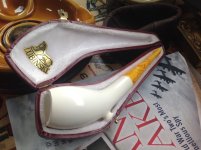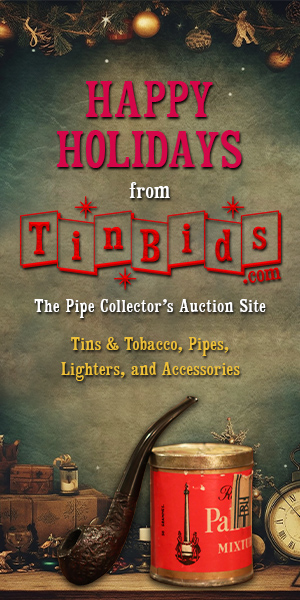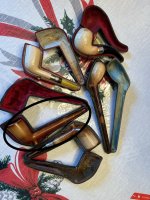You have to be a 10 on the 'Absorption Scale' to get a 'turd' colored one!
How to Avoid Bad Coloration?
- Thread starter UrsaMinor
- Start date
You are using an out of date browser. It may not display this or other websites correctly.
You should upgrade or use an alternative browser.
You should upgrade or use an alternative browser.
SmokingPipes.com Updates
Watch for Updates Twice a Week
According to the Tinderbox web site, Turkish meerschaum is separated into five categories (grades) with 12 qualities in each. Grading is based on size, density, color, and homogeneity.
The meerschaum man at Springfield sold a lot of pipes explaining that to the ladies.
Meerschaum is a white mineral. But the experts in Turkey have 60 different combinations of grade and quality to carve pipes from.
Tinder Box International: Helpful Tips - Pipes & Pipe Smoking - The Story of Your Meerschaum Pipe
The Official Tinder Box Site featuring Tinder Box stores and the finest in tobacco, pipes, cigars and unique gifts
www.tinderboxinternational.com
The meerschaum man at Springfield sold a lot of pipes explaining that to the ladies.
Meerschaum is a white mineral. But the experts in Turkey have 60 different combinations of grade and quality to carve pipes from.
Mucky Meershaums & Charlie Rich? No thankyou, I have an intense dislike for both. I wash my meers, inside & out with ‘Fairy Liquid’. Apart from keeping my pipe looking crystal, it also keeps one’s hands luxuriously soft & supple.
I’ve had this pipe several years now & despite over thousands of bowls I think it still looks spiffing!

I’ve had this pipe several years now & despite over thousands of bowls I think it still looks spiffing!

That would be the pipe you dedicate to Lakelands thenMucky Meershaums & Charlie Rich? No thankyou, I have an intense dislike for both. I wash my meers, inside & out with ‘Fairy Liquid’. Apart from keeping my pipe looking crystal, it also keeps one’s hands luxuriously soft & supple.
I’ve had this pipe several years now & despite over thousands of bowls I think it still looks spiffing!
View attachment 198658
A big welcome to the PM monthly discussion about meerschaum coloring. This month we are offering a 15 lb block of bees wax to the most original wives tale on pipe coloring. Without further ado the floor is now open to all.....
A Treatise on
The coloring of meerschaum pipes.
By
G.O. Effyercelf
The coloring of meerschaum pipes.
By
G.O. Effyercelf
Meerschaum, aka the white goddess, foam of the sea, is a mysterious substance mined from the earth and formed into pipes by craftsmen once mostly located Vienna and now residing almost solely in Turkey. For nearly 3 centuries this magical white stone has been used to craft some of the finest smoking instruments and not infrequently, unidentifiable pipe shaped objects. I will lay bare before you the secrets to achieving the elusive, deep, even, and intense colors that are often seen in the meerschaum pipes of old, the jet blacks, ruby reds, and royal purples that so many treasured pipes of centuries past display.
Let’s start with the manufacturing of 18th and 19th century meerschaum pipes. This was largely done by craftsmen in the Vienna, Austria the once meerschaum pipe capital of the world. The Austrian carvers used only finest Turkish meerschaum from mines located in Eskisehir. These carvers used the finest tools made from German Solingen steel which has an unusually high carbon and nickel content. This high nickel/carbon content was crucial to pipe manufacturing as it imbued the pipes with a slightly elevated NICO3 level which enabled the completed pipes to bond with the tars and oils produced in the combustion of tobacco better, thus allowing them to color much faster than pipes produced with inferior tools today.
Once the high NICO3 stummles were completed they were treated with spermaceti, an oily substance found in the forward cranial cavity of a sperm whale. It was well known to the pipe houses of Vienna at that time that the quality of the spermaceti was paramount to the successful coloring of pipe. For instance, if a whale had led the whale boat on a Nantucket sleigh ride it would have suffered and therefore the spermaceti would be fouled and hence produce uneven coloring in a pipe. Whales taken in the northern parts of the Bearing Sea were much preferred to other whales because the temperature and salinity of the Bearing Sea were ideal for optimal spermaceti with whales taken other regions having higher triglyceride levels consequently producing inferior spermaceti form pipe production. Spermaceti with elevated triglyceride levels was known to cause pipes to color incompletely, meaning the pipes would only color about halfway up the bowl.
After treatment with spermaceti the pipes would be waxed with beeswax of the highest quality. The first meerschaum pipe beeswax harvesting operation was granted to the Austrian Archduke Charles, Duke of Taschen in 1815 as part of the dowery of his wife Henrietta of Nassau-Weilburg by her father. The hives were located on the south face of Mont Grossglockner and were tended by Franciscan Friars. Very little is known about the hives as the friars were a very secretive lot closely guarding the process by which the superior wax was produced. It has been speculated the flowering plants that grow below the tree line of Mont Grossglockner offered some element to the wax that we are currently unaware of.
Upon completion of the oiling and waxing processes the pipe was stemmed with a genuine Russian amber bit. Russian amber falls into the category of class I amber, more specifically class Ia which has a communic acid base as opposed to the class II amber with a sesquiterpenoid base. This communic acid-based amber is the reason that pipes will start to color from the shank forward. The acids leach into the meerschaum creating a covalent bond that promotes greater molecular expansion under the application of heat. Over time the acids will transfer completely from the stem to the pipe thus causing the stem to deteriorate rapidly. These pipes must have their stem replaced with a Russian amber stem of comparable quality or the coloring process will be halted.
The first thing a smoker would do upon procurement of a new meerschaum pipe was to requisite the proper accessories they would need to begin successfully coloring their pipe. Very little thought was given to enjoyment of smoking as coloring was the principal goal. This arduous process was started by first being fitted for a single pipe smoking glove crafted from the finest calfskin. These gloves were made primarily in Morocco. The tanning process used by the Moroccan tanners did not leave any agents in the leather which could impede the coloring process. It is worth noting that pipe gloves were typically fitted for the non-dominant hand of the smoker because this promoted more delicate handling than dominant hand smoking did. Next a suitable coloring bowl was fitted to the pipe to prevent any burning tobacco from ever meeting the interior of the tobacco chamber. Coloring bowls were typically produced in Monaco of premium African block meerschaum. African meerschaums resistance to coloring was ideal as this prevented any color from being absorbed by the coloring bowl itself and not being transferred to the pipe.
Before the coloring bowl was inserted in the pipe a suitable tobacco was selected for a plug, this would be inserted the pipe but never smoked. This would act as a trap for the fusil oils in the tobacco smoked in coloring bowl. The oils would after time adversely affect the flavor of the tobacco being smoked but since smoking enjoyment was for those of a lower class it was tolerated. The tobacco most used for the plug was pure semois as it the most absorbent and is considered by most to have a neutral flavor.
The tobacco smoked in the coloring bowl was equally important to that of the plug. A now little-known French tobacco produced by a firm by the name Malodorant Homme in Paris called Affreux Melange was the preferred blend for coloring, its room note was often compared to that of burning horse dung. It was said to have notes of shoe leather and rotten squash with hints of burning hair. The recommendation was to smoke it as moist and rapidly as possible allowing the steam to permeate the semois plug in the pipe itself. This was to be done as often as permitted without pause.
If all the steps laid before you here are followed without deviation for a minimum 100 – 150 years you should achieve the loveliest shades of feces brown in at least one half of the shank of your pipe. With some luck enthusiasts will engage in heated discussion about your pipe on the internet long after you’ve left this world.
Meerschaum more durable than briar? Not in this universe. Historically, the rise of briar for pipe smoking in the early 1850's was due to both it's durability and ease of use over the meerschaum and clay pipes then in use. And 170+ years into the revolution, nothing has changed. Briar still dominates. As for longevity, both are capable of deliving for well over a hundred years. One of the briars that I smoke is 140 years old.@cosmicfolklore
They are supposedly more durable than briars and require less care. That's my main reason for wanting one. But if they eventually start to look like they were dragged through the mud, it's hard to justify the cost.
@warren
Looks are part of it, I suppose. I guess I need to do more resarch.
Meers represent their own kind of smoking experience and many smokers enjoy both.
As for the meer you were admiring for the evenness of its color, that's a dye job. Pipe makers have been dying meers since the 19th century. Besides the honey color you can find them dyed to a deep ruby red, or given a graduated paint job that goes from honey to a soft edged warm black near and atop the rim. Maybe you would be happiest with a dyed meer, one with a finish that you like.
Last edited:
@rustiepyles : I think we might have a winner here!
That wax better be Grossglockner wax@rustiepyles : I think we might have a winner here!
There’s always the option of pre-coloring. Or post pre-coloring (after you decided it looks ugly).
I wanted to soften out my mirror a little bit, and I hit it with a hairdryer and all the colors started to blend. I read about coloring consistently with some “tobacco tea” and I tested that on one and it gave a pretty consistent brownish.
You don’t have to let the pipe get ugly, if you feel it has then you can fix it.
I wanted to soften out my mirror a little bit, and I hit it with a hairdryer and all the colors started to blend. I read about coloring consistently with some “tobacco tea” and I tested that on one and it gave a pretty consistent brownish.
You don’t have to let the pipe get ugly, if you feel it has then you can fix it.
I wonder if smoking my pipe upside-down will affect the coloring...A big welcome to the PM monthly discussion about meerschaum coloring. This month we are offering a 15 lb block of bees wax to the most original wives tale on pipe coloring. Without further ado the floor is now open to all.....
meers only color during full moons. If you smoke it under a new moon it actually goes white. The reason African Meers don't color is because they don't have the moon there yet.A big welcome to the PM monthly discussion about meerschaum coloring. This month we are offering a 15 lb block of bees wax to the most original wives tale on pipe coloring. Without further ado the floor is now open to all.....
This explains why my meer has so much color though I only smoked it 4 times! Coincidently it was when the moon was large. Thanks @anotherbob!!meers only color during full moons. If you smoke it under a new moon it actually goes white.
FACTS!!!This explains why my meer has so much color though I only smoked it 4 times! Coincidently it was when the moon was large. Thanks @anotherbob!!
Buying a meerschaum with a preconceived expectation as to how it will/should color is ... well, as waste of money and effort. It's a naturally occurring mineral. The meer will color as it will. Your chances of even coloring will be somewhat enhanced by properly caring for the smoking tool. And what is proper care? I have my opinion and others have opinions which differ. Lotsa luck?
Never heard that one before and personally haven't noticed it beyond breaking them in.Isn't the general view that Meers get better when they develop a patina?
It can be added to the list of things that get more respectable with age.Never heard that one before and personally haven't noticed it beyond breaking them in.
Whores, buildings, and Meerschaum Pipes.
I always find it amusing that people will pay top dollar for a heavily colored meerschaum. It's just a dirty filter.It can be added to the list of things that get more respectable with age.
Exactly! I love my filters, the dirtier the better, right?It's just a dirty filter.
I buy them a pristine white then, dirty them up ... all by my lonesome self.








